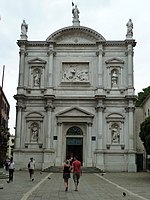Scuola Grande di San Giovanni Evangelista

The Scuola Grande di San Giovanni Evangelista is a confraternity building located in the San Polo sestiere of the Italian city of Venice. Founded in the 13th century by a group of flagellants it was later to become one of the five Scuole Grandi of Venice. These organisations provided a variety of charitable functions in the city as well as becoming patrons of the arts. The Scuola Grande di San Giovanni Evangelista is notable for housing a relic of the true cross and for the series of paintings it commissioned from a number of famous Venetian artists depicting Miracles of the Holy Cross. No longer in the school, these came into public ownership during the Napoleonic era and are now housed in the Gallerie dell'Accademia. The scuola is open to visitors on a limited number of days, detailed on the official website.
Excerpt from the Wikipedia article Scuola Grande di San Giovanni Evangelista (License: CC BY-SA 3.0, Authors, Images).Scuola Grande di San Giovanni Evangelista
Campiello De La Scuola, Mestre Venezia-Murano-Burano
Geographical coordinates (GPS) Address Nearby Places Show on map
Geographical coordinates (GPS)
| Latitude | Longitude |
|---|---|
| N 45.438 ° | E 12.326 ° |
Address
Chiesa di San Giovanni Evangelista
Campiello De La Scuola
30170 Mestre, Venezia-Murano-Burano
Veneto, Italy
Open on Google Maps










